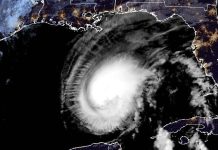Sept. 6 (UPI) — The National Hurricane Center said Wednesday Hurricane Irma has passed over St. Martin and the storm’s eyewall is bearing down on the Virgin Islands.
The NHC said in its latest advisory that the storm’s center was about 140 miles east of San Juan, P.R. and 65 miles east of St. Thomas. It recorded maximum sustained winds of 185 mph while moving west-northwest at 16 mph.
Forecasters said the track of the storm — the path Irma’s expected to take — shifted slightly to the east early Wednesday, but is uncertain beyond about three days. It could approach South Florida by Saturday and travel up Florida’s center, or along its Gulf or Atlantic Coast.
“On the forecast track, the extremely dangerous core of Irma will move over portions of the Virgin Islands very soon, pass near or just north of Puerto Rico this afternoon or tonight, pass near or just north of the coast of the Dominican Republic Thursday, and be near the Turks and Caicos and southeastern Bahamas late Thursday.,” the NHC said.
“Some fluctuations in intensity are likely during the next day or two, but Irma is forecast to remain a powerful Category 4 or 5 hurricane during the next couple of days.”
Irma’s hurricane-force winds can be felt as far as 50 miles from its center. Tropical-storm-force winds extend up to 185 miles from Irma’s center, the NHC said.
“A National Ocean Service station on Barbuda reported sustained winds of 118 mph with a gust to 155 mph before the instrument failed earlier this morning,” an earlier advisory said.
Irma’s wind speeds make it the strongest hurricane in the Atlantic basin, outside the Gulf of Mexico and Caribbean Sea, in the NHC’s recorded history, the center said. Colorado State meteorologist Philip Klotzbach said Wednesday morning that Irma set an Atlantic hurricane record by having maximum wind speeds of at least 180 mph for 24 hours.
President Donald Trump on Tuesday evening declared a federal emergency for Florida, Puerto Rico and the U.S. Virgin Islands, making federal funds available for preparation ahead of Irma.
Irma became the ninth named Atlantic storm of the season Wednesday, following Harvey. The tenth named Atlantic storm, Jose, formed in the Atlantic earlier Tuesday — and the eleventh, Katia, early Wednesday.






